● ● ●
The
study of the military history of World War II
requires an understanding of air force organizations and
aircraft types, so that
when reading of a "fighter group” or an "air division" their
size and capabilities can be envisioned. In modern times most
air forces worldwide have
employed similar organizational templates. These are
defined below for WW II air forces using the 1943-45 US Army
Air Forces organizations as examples, and
are broadly applicable to the French British, Italian and
other 1939-45 European air forces, with variations noted.
Brief descriptions of the major aircraft types employed by
the air forces of World War II are also provided.
AIR FORCE STATUS
Most World War II air forces
originated as corps or branches of armies and navies, e.g.
the British Army's Royal Flying Corps and the Royal Naval
Air Service. In 1918 the two were amalgamated to form the
Royal Air Force (RAF), a branch of the armed forces coequal
with the Army and the Royal Navy. The RAF was thus the
world's first independent air arm.
At the beginning of World War II,
Britain, France, Germany and Italy among the major
belligerents had independent air forces. The US air force
remained an Army branch: the US Army Air Corps (USAAC). In
1942, however, the creation of the US Army Air Forces made
the US air arm autonomous in all but the most formal sense.
Technically it was a command embracing the USAAC and units
from other Army branches such as the Quartermaster Corps and
Ordnance Corps that were necessary to support air
operations. However, the US Navy's aviation branch remained
separate from the USAAF.
The air forces of the USSR and the
Japanese Empire were branches of their armies and navies,
and remained so throughout the war.
MILITARY AIRCRAFT TYPES
Bomber (light, medium, heavy):
Usually a twin- or four-engine aircraft with a crew of 4-8;
employed for both strategic and tactical attack. Examples
were the US Douglas A-20 Havoc (light), the German Do-17Z
(medium) and the British Avro Lancaster (heavy).
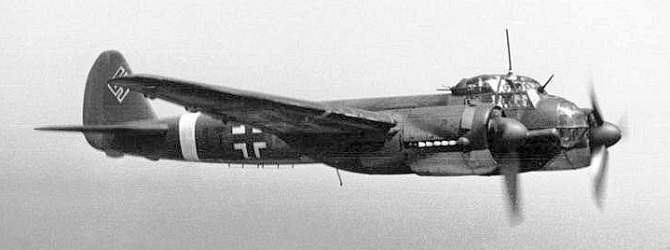
Ju-88A medium bomber of
the Luftwaffe (Bundesarchiv)
Dive Bomber: A single-engine
aircraft that, as its name implied, delivered its bomb load
in a steep dive; mostly used for close air support of ground
troops and battlefield interdiction. The best-known aircraft
of this type was Germany's Ju 87 Stuka.
Ground Attack Aircraft: An
aircraft purpose-designed for the close air support mission,
e.g. the Soviet
Ilyushin
Il-2
Shturmovík,
of which over 42,000 were built.
Fighter: A single- or twin-engine aircraft designed for
air-to-air combat. Examples were the US North American P-51
Mustang, the British Supermarine Spitfire (both
single-engine) and the German Bf 110 (twin-engine)
Fighter-Bomber: A fighter
aircraft capable of carrying bombs or air-to-ground rockets,
mostly used for close air support of ground troops. An
example was Britain's Hawker Hurricane Mk IIC, which could
carry a pair of 250-lb or 500-lb bombs, one under each wing.
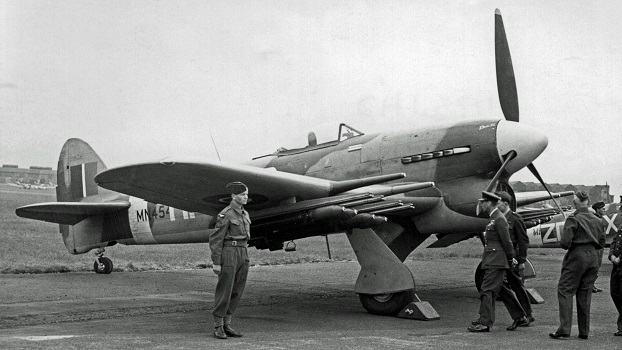
Hawker Typhoon
fighter-bomber of the RAF, armed with air-to-ground rockets
(Imperial War Museum)
Night
Fighter: An aircraft, usually twin-engine, equipped with
air-to-air radar and configured for night air defense. Many
examples of the type were modified light or medium bombers,
e.g. the US P-70, based on the A-20 light bomber. Others
were purpose built, e.g. the German He 219.
Reconnaissance Aircraft: Single- or twin-engine aircraft
equipped with cameras for tactical and strategic
reconnaissance. Most were modified light/medium bombers and
fighters, e.g. the German Ju-88 (modified medium bomber) and
the US F-5 (modified P-38 Lightning fighter), but some were
purpose built, e.g. the German Fw 189.
Maritime Reconnaissance Aircraft: Twin- or four-engine
aircraft employed for ocean patrol and antisubmarine
operations. Most were modified medium and heavy bombers;
some were flying boats. Examples were the US Consolidated
B-24 Liberator (modified four-engine heavy bomber) and the
British Short Sunderland (four-engine flying boat).
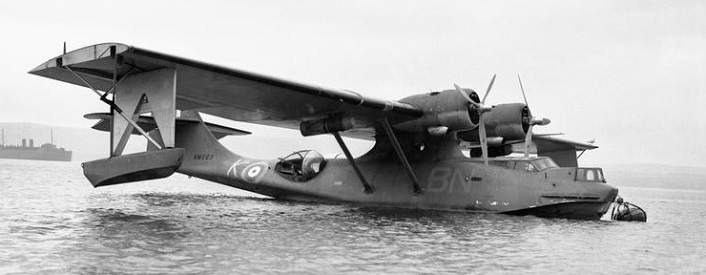
US-manufactured PBY-5
flying boat of RAF Coastal Command (Imperial War Museum)
Army
Cooperation Aircraft: Light single-engine aircraft
employed for various duties in support of ground forces,
such as artillery observation, liaison, communications,
staff transportation, etc. Some were unarmed but others had
one or two machine guns and could carry light bombs.
Examples were the US
Stinson L-5 Sentinel
(unarmed) and the German Hs 126 (armed).
Transport Aircraft:
Many aircraft of this class were militarized variants of
civilian airliners, the outstanding example being the US
Douglas C-47 Skytrain, based on the revolutionary
twin-engine DC-3 airliner. The German equivalent was the
Ju 52, a trimotor design that also served the prewar
Luftwaffe as a bomber. Transport aircraft performed a
wide range of vital missions: moving passengers and freight,
airlifting supplies to front-line troops, flying
paratroopers into combat etc.
Training Aircraft:
Though often overlooked, training aircraft played a vital
role, preparing the pilots and aircrew necessary to man
front-line air units. Many were purpose built but some, like
the British Fairey Battle I light bomber, were former combat
types retired from active service. The US North American
AT-6 Texan is perhaps the best-known trainer of all time,
having served in large numbers with many air forces
worldwide
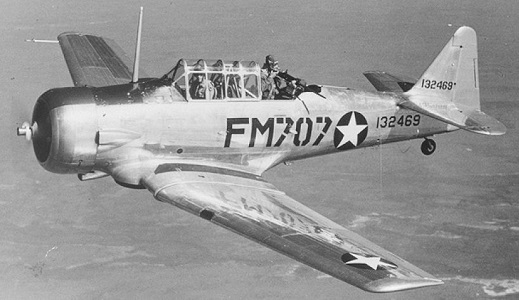
AT-6 Texan advanced
trainer of the US Army Air Corps (US War Department)
THE WESTERN ALLIED AND
AXIS AIR FORCES
FLYING UNITS
Flight:
3-4 aircraft. The Luftwaffe equivalent was
the Schwarm.
Squadron: 3-4 flights; 12-16
aircraft. The Luftwaffe equivalent was the Staffel.
Group: 3-4 squadrons; 36-64
aircraft, sometimes with 2-4 additional aircraft held in
reserve. In the Royal Air Force (RAF), this echelon of
command was called a wing. The Luftwaffe equivalent
was the Gruppe.
Wing:
4-6 groups; in the Royal Air Force (RAF),
this echelon of command was called a group. The
Luftwaffe equivalent was the
Geschwader.
Air Division / Command: 3-4
wings. The Luftwaffe equivalents
were the
Fliegerdivision and the Fliegerkorps.
Numbered Air Force: usually
4-6 air divisions /commands. The Luftwaffe equivalent
was the Luftflotte
GROUND ORGANIZATION
Air forces required considerable
technical and logistical support, and the ground
organization providing this was accordingly extensive and
complex. In all air forces there were numerous specialized
units for air intelligence, air traffic control, weather
forecasting, security, antiaircraft defense, maintenance,
supply, medical support, etc., etc. This infrastructure
could be fixed, as it was for the US Eighth Air Force, and
RAF Bomber Command, operating from bases in the UK
throughout the war, or mobile, as it was for the tactical
air forces operating in support of the armies in the field.
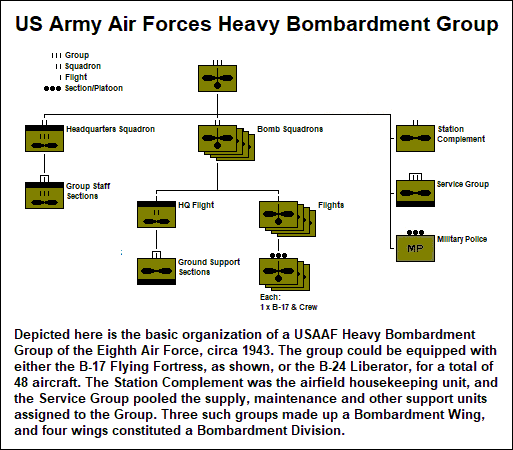
NOTES
The air division /
command was the highest USAAF echelon organized around a
single aircraft type: fighters, medium bombers, etc. In the
RAF the highest such echelon was the wing and in the
Luftwaffe it was the Fliegerdivision. There were
occasional exceptions to the single-type rule, e.g. the VIII
Composite Command of the US Eighth Air Force.
RAF squadrons had a
separate identity and could be transferred between wings as
required. The majority of USAAF flying squadrons were
organic to a group and were rarely if ever transferred
elsewhere. Independent flying squadrons of the USAAF were
mostly specialized units, e.g. the 36th Bomb Squadron flying
modified B-24s in the radar countermeasures role. In the
Luftwaffe, the Gruppe was the basic tactical unit
and the Gruppen of a
Geschwader
were often detached. There were also independent Gruppen
and Stafflen.
The Royal Italian Air Force (Regia
Aeronautica)
was organized much like the Luftwaffe. Its basic flying unit
was the
Stormo
(wing) consisting of two or three Gruppi
(groups), each with two or three Squadrigli
(squadrons) operating a single aircraft type (fighters,
bombers, etc.). As with the Luftwaffe Gruppen, a
Gruppo could be detached from its parent Stormo.
There were also independent Gruppi and Squadrigli,
mostly with reconnaissance, observation, transport and
utility aircraft. Higher headquarters were air brigades, air
divisions and area commands or air forces.
The basic
unit of the Imperial Japanese Army Air Service was the Air
Combat Group with three squadrons, roughly the size of a
Gruppe of the Luftwaffe, flying a single aircraft
type. An Air Combat Group and its supporting units,
including various independent flying squadrons, constituted
an Air Brigade; two or more of these formed an Air Division.
The highest echelon of command was the Air Army.
THE RED
ARMY AIR FORCE OF THE USSR
FLYING UNITS
The basic unit of the Red Army Air
Force was the regiment, operating a single aircraft type
(fighter, ground attack, etc.), and usually consisting of
three or four squadrons. The next higher echelon was the
aviation division, which could be either single type (e.g.
6th Guards Bomber Aviation Division) or mixed (e.g. 8th
Mixed Aviation Division with fighters and ground attack
aircraft). The division usually had three or four regiments
under command. The aviation corps usually was single type,
controlling two divisions. Finally, the air army, attached
to a Red Army front, could control up to a dozen corps and
independent divisions. There were also independent regiments
and squadrons for reconnaissance, artillery observation,
transport, etc.
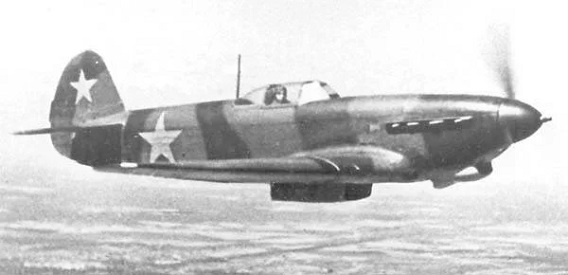
Yak-9 fighter of the Red
Army Air Force (Red Army photo)
The Workers-Peasants Red Army Air
Forces, as it was officially titled, was a tactical air
force; throughout the war it operated almost exclusively in
support of the Red Army. Its principal aircraft were
fighters, fighter-bombers, ground attack aircraft, and light
and medium bombers. At the beginning of the war there was a
Long Range Aviation Corps equipped with twin-engine and a
few four-engine bombers that made a number of night attacks
on Berlin and other targets in Germany, but the Red Army Air
Force never developed the capability to conduct a sustained
strategic air offensive against the German homeland. Like
Britain and other Allied nations, the Red Army Air Force
employed significant numbers of US aircraft supplied via
Lend-Lease.
An
excellent source of information on the military
organizations of all countries during WW II is Dr.
Leo Niehorster’s website,
World War II Armed Forces: Orders of
Battle and Organizations.
● ● ●
Copyright © 2020 by Thomas M.
Gregg. All Rights Reserved

BACK to WAR ROOM
Front Page